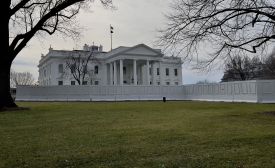The five leaders of the 21st Century IDEA

The countdown to 2020 has officially begun, and as we say goodbye to another year, the federal government is poised to recognize momentous milestones for policies that are not only transforming operations but also improving user experience for digital services and helping maximize their cost savings.
One of these key milestones is the first anniversary of the 21st Century Integrated Digital Experience Act (21st Century IDEA), which was authored by Rep. Ro Khanna, D-Calif., and signed into law Dec. 20, 2018. Similar to the President’s Management Agenda Cross-Agency Priority (CAP) Goal, the 21st Century IDEA is also focused on improving customer experience with federal services.
The law strives for a more consistent, mobile-friendly user experience across federal digital services and websites. Essentially, it requires agencies to take stock of their public-facing digital assets and streamline and modernize them for the 21st century.
Departments and agencies may want to consider using this milestone as an opening to assess their critical technology investments that can support their unique missions and meet the ongoing benchmarks outlined in the 21st Century IDEA. This is a terrific inflection point and opportunity.
Because there are many competing demands on agencies, it is hard to meet these significant benchmarks on citizen experience. Nearly everyone sees it as something that is sorely needed, and leaders should be applauded when they prioritize these citizen-facing touchpoints over the operating and maintaining legacy systems budget black holes. That is bold leadership with real impact. In fact, the federal government continues to spend 80 percent of its IT budget on legacy technologies, according to the U.S. Government Accountability Office — that’s nearly $72 billion in total. This model is not only unsustainable, but it also precludes federal agencies from meeting requirements outlined in the 21st Century IDEA, spanning from website modernization to the digitization of government forms and accelerating the use of electronic signatures.
As the 21st Century IDEA celebrates its first anniversary, we’re already seeing strong agency leadership that prioritizes IT spending on long-lasting technologies to help citizens and employees. Here are five federal agencies and departments that are paving the way to meet the tenets of the 21st Century IDEA:
Department of Commerce/U.S. Census Bureau
For the U.S. Census Bureau, 2020 will serve as an inflection point because for the first time in nearly 230 years, the census tabulation is going digital. Citizens will now have the option to complete the census online, by phone or through the mail, which will provide a more seamless experience for citizens to submit their responses wherever they are and through whatever device they choose. The U.S Census Bureau is a leader in meeting the 21st Century IDEA requirements through its design of a mobile-friendly website that is configured to drive efficiency and cost savings. The digital migration is expected to save billions of dollars in the coming years and will likely lead to greater participation in the census. For instance, the Census Bureau projects nearly 55 percent of the U.S. population will respond to the census online – that alone amounts to nearly three-quarters of the total respondents during the 2010 census.
U.S. Department of Housing and Urban Development
Upon joining the General Services Administration’s Centers of Excellence, the U.S. Department of Housing and Urban Development (HUD) set a goal to migrate more than 950 paper-based forms to mobile-friendly, cloud-hosted forms. Through this modernization effort, HUD integrated best-in-class technology with existing government services, ensuring that all Americans – especially senior citizens – have the necessary tools available to obtain affordable housing. As a result of digitizing its broad swath of paper-based forms, HUD also meets a benchmark outlined in the 21st Century IDEA, which requires all forms to be digital by December 2020.
General Services Administration
The General Services Administration (GSA) often carries the torch when it comes to digital government transformation. Whether it’s the Technology Transformation Services (TTS), which helps agencies build, procure or share technology or the Office of Customer Experience (OCE) which is responsible for ensuring customer needs are top of mind when making critical decisions, the GSA oversees several organizations that assess the current state of its digital services and identify ways to improve these services. The GSA has already put together a multi-disciplinary team to guide GSA as they inventory and assess their digital services to meet the 21st Century IDEA’s vision of improving digital experiences across government. GSA’s Digital.gov team is also working on creating more visibility around the Federal Web Council and the work that they’ve been doing around 21st Century IDEA.
U.S. Department of Energy
The Office of Energy Efficiency and Renewable Energy (EERE) within the U.S. Department of Energy sits at the forefront of innovation, as it is responsible for transitioning the nation to embrace a global clean energy economy. The Department took a forward-looking approach to updating its website and forms. Through the redesign of its website, the EERE incorporated visually compelling infographics about taxpayer investments to seamless access to digital forms for grant funding applications, ensuring a greater user experience for citizens.
U.S. Department of Agriculture
The U.S. Department of Agriculture (USDA) launched a series of programs that align with the key objectives of the 21st Century IDEA. One standout program is the Voice of Customer initiative, which enables employees to leverage data analytics and feedback to identify the customer needs and execute strategies to accommodate them. In addition, the USDA continues its efforts to consolidate data centers and update Farmers.gov, a site dedicated to helping U.S. farmers obtain services, such as a farm loan, faster than ever before.
Although these five agencies are paving the way when it comes to digitizing their services, other agencies, such as the U.S. Department of Veterans Affairs (VA), the National Aeronautics and Space Administration (NASA) and the U.S. Department of Labor (DOL), are also making great headway. To celebrate the one-year anniversary of the 21st Century IDEA enactment, citizens and government employees alike take comfort in knowing their government is focused on activities that directly impact their lives, such as modernizing forms and websites, as outlined in 21st Century IDEA.
In short, as we celebrate the first year of the 21st Century IDEA enactment, it is heartening to see such a tremendous early impact for citizens, and there is still so much more to come.
Jace Johnson is VP of Global Government Relations & Public Policy for Adobe.





